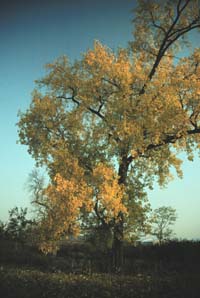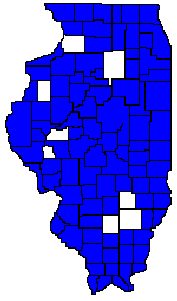 |
| Cottonwood
(Populus deltoides)
Distribution
Map to Right |

Cottonwood, also known as eastern cottonwood, Carolina poplar, eastern poplar, and necklace poplar, is one of the tallest eastern hardwoods. It grows to heights of 150 - 200 feet. It has a tall, straight trunk, typically with a diameter of up to 8 feet (a cottonwood in Grundy County, Illinois reportedly has a trunk diameter of 9 feet). The crown is oblong or spreading and broadly rounded with some hanging branches.
Eastern cottonwood grows along streams in floodplains and in bottomland woods. It is present in almost every county in Illinois, but is most abundant along the rivers and streams and in bottomland woods. It has a wide distribution in the Eastern United States, and is only notably absent there from the higher areas in the Appalachians. It extends on the northern edge of its range from Quebec to North Dakota, south to Texas and back east to Georgia and northwestern Florida.
Interesting
Facts
Eastern
cottonwood prefers well-drained fine sandy or silty loam soils. In the
lower Mississippi River Valley, it reportedly grows best on the land between
levees and the river, on banks and ridges of former stream courses and
well-drained lowland flats. The seedlings require moist mineral soil for
development and are easily damaged by fungus and prolonged periods on time
in hot sun.
The roots are initially so slow to develop that the seedling is at risk of being dislodged by raindrops. After several weeks, root growth accelerates. Overall growth of cottonwood is very rapid, but the tree is short-lived. Cottonwood is very shade intolerant. It is a good pioneer (first to colonize an area) species because of its rapid growth and size. It does not respond well to crowding and does not respond to gaps with a growth spurt. It doesn't survive prolonged flooding as well as willow and therefore tends to occupy the slightly higher, drier sites in the floodplain.
Identifying Features
Bark
Eastern cottonwood bark is smooth and yellow green to gray when young, becoming ash brown to gray, corky, and deeply furrowed with age.
Twigs
The twigs are tan or yellowish green to gray and smooth with noticeable lenticels (small openings or spongy areas in the cork surfaces that facilitate gas exchange between internal tissues and the atmosphere through the bark).
Buds
The terminal buds are 1/4 - 1/2 inch long, yellow green, and pointed. They may also be sticky.
Leaves
The leaves are alternate, simple, and roughly triangular. They are up to 6 inches long and from 3-6 inches broad. They are pointed at the tip, with coarse, rounded teeth at the edges. The base is cut straight across, or slightly rounded. They are shiny green above and paler beneath. The leafstalks are up to 4 inches long, and often yellow and flattened.
Flowers
Eastern cottonwood is dioecious; male and female flowers are borne on separate trees. The flowers appear as the leaves begin to unfold very early in the spring. Both male and female flowers are crowded into catkins, the male flowers in thick, reddish-colored catkins and the female flowers in slender greenish-yellow catkins.
Fruits
The fruits are small elliptic, greenish-brown capsules, 1/4 inch long. They hang in clusters, each containing numerous seeds with the familiar cottony hairs that aid in wind dispersal.
Uses
Eastern
cottonwood wood is light-weight and soft. It is used for pulpwood and fuel.
It is planted as an ornamental for shade and there is interest in developing
it as a a source of cellulose in cattle feed because the new growth is
high in protein and minerals and relatively free of tannin.